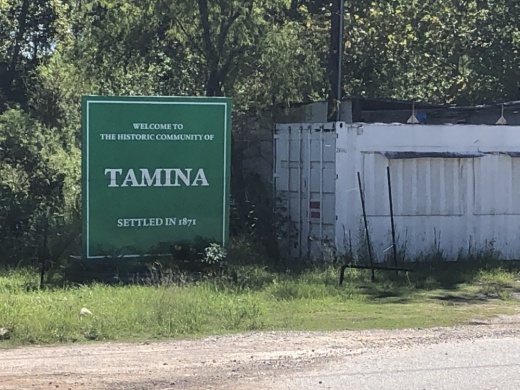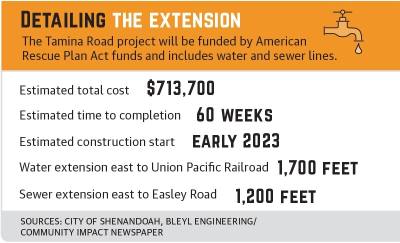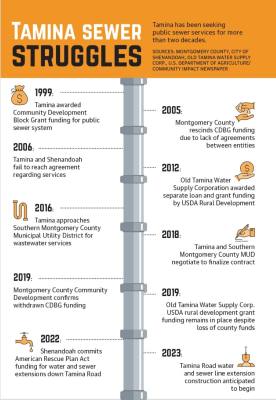The $713,700 project, which will extend an existing water line 1,700 feet and extend an existing sewer line 1,200 feetbetween David Memorial Drive and Easley Road, is largely being funded through American Rescue Plan Act funds as part of federal COVID-19 relief.
Shenandoah received more than $740,000 in ARPA funding, and city officials said the project falls within the guidelines and scope for which the federal money is approved. Upon completion, the project will allow the city to provide water and sewer services for property owners and businesses along the stretch of Tamina Road, which is currently served by septic and aerobic systems to treat wastewater, Shenandoah Public Works Director Joseph Peart said. Several dozen current and future property owners and businesses on that section of road will have the option to receive water services from either the city or the nonprofit Old Tamina Water Supply Corp.
The project was approved during a March 23 Shenandoah City Council meeting, and it is awaiting the second round of ARPA funding until surveying can begin, said John Bleyl, president and CEO of Bleyl Engineering.
“The city purchased property many years ago for this intended purpose, which will help with the construction of this project,” Peart said. The historically Black Tamina community, which includes a portion of Tamina Road, has been trying to get public sewer services since 1999.
Berry King, owner of Bks Hand Car Wash and Detailing on Tamina Road, said he hopes the services will help attract more businesses to the area.
“It is kind of hard to open up a business or anything other than what we are doing right now,” King said. “The [cost to install] the old aerobic systems is $10,000 to $15,000, and a lot of people cannot afford that.”
Bleyl said once the water and sewer lines are complete, property owners west of the Union Pacific Railroad at Johnson Road will have access to the city’s utilities. Businesses located between David Memorial Drive and Johnson Road include Sycamore Creek Ranch Memory Care and Emmanuel Church of God. Peart said any future extensions to the project will need to be funded by ARPA funds.
Shenandoah Mayor Ritch Wheeler noted the project will not solve the ongoing problems with Tamina’s sewage infrastructure, but said it will be a start.
“They have been dying for water and sewer for quite some time,” Shenandoah City Council Member Ron Raymaker said of Tamina. “We are able to help them, we are able to help our infrastructure and help our ETJ.”
Scope of the project
Council members have voiced their support for the project, stating it will increase property values along the road as well as saving money for taxpayers because it is mostly covered by ARPA funding.
“With the improvements on Tamina Road, that is only going to bring property values up for that section of the city,” Council Member John Escoto said at the March 23 meeting.
While there is no set date to begin for the water and sewer project, Peart and Bleyl said they hope to begin construction by early 2023. Proposal documents submitted to City Council indicate it will take an estimated 60 weeks to complete, including surveying, designing, bidding and construction. Peart said there will be coordination with Montgomery County Precinct 4 as the project will be near the county’s right of way as it approaches Hardy Road just east of the Union Pacific Railroad.
Peart said a complication with extending the sewer line on the north side of the road deals with the elevation difference between the sewer and Johnson Road.
“A lift station would be required to extend beyond this point, which would exceed the funding,” Peart said.
During the March 23 meeting, City Council approved using the ARPA funding for the project and added a redundancy sewer line to the city’s wastewater treatment plant. Excess costs beyond what the ARPA funds cover will be covered by Shenandoah’s water and sewer fund, Peart said.
Peart said Shenandoah’s capital improvement plan includes funds for other repair and replacement projects for the water and wastewater systems, but the new projects qualify for ARPA funds.
“These projects are new and meet the purpose of the [ARPA] funding,” Peart said.
Tamina sewer service issues
The community of Tamina, which was founded in 1871 by freed slaves after the Civil War, has been working to get public sewer services for over two decades. According to 2020 U.S. Census data, there are 423 residents within the census blocks in the Tamina era, with 97 estimated along the stretch of Tamina Road the proposed project covers.
Rita Wiltz, a Tamina resident and founder of Tamina nonprofit Books on Wheels, said she is hopeful the project will mean she and her family will see water services in their lifetime.
“My mother, Della Henry, worked for years ... to make sure the families in Tamina ... had water and sewer,” Wiltz said. “She passed in 2017, and we still did not have that.”
Wiltz said her family has never given up on trying to bring services to Tamina.
“As long as I can remember, it has always been a concern,” she said. “You have families that have a slop bucket. ... When you do not have indoor plumbing, that is what you use for the bathroom.”
According to Jennifer Brady, public affairs specialist with the U.S. Department of Agriculture Rural Development, the OTWSC, which supplies water services to the Tamina community, was awarded around $2.2 million in loan and grant funding to construct a wastewater collection system and treatment plant in 2012. However, as of 2022 it has not yet been used because it is awaiting final project plans from Tamina to close the loan, she said.
“The agency is awaiting final plans and specifications for the proposed project from the WSC’s consulting engineer to close the loan/grant and move towards construction,” Brady said in an email.
James Leveston, president of the OTWSC, declined to comment on the status of the project plans as of April 28 due to ongoing talks with the various entities.
Brady said there is a date the funds need to be used by but did not specify the date. She said the USDA Rural Development agency is committed to ensuring the funding will go to the OTWSC before it expires.Precinct 4 Communications Officer Jean Mann said the county also is waiting on information from Tamina to move forward with the process.
Bleyl said for now, the city’s focus will be on bringing water services to the railroad right of way as the first step of the process.
Wiltz added she is concerned about how residents’ ability to connect to the lines once they are completed.
“We will say ‘amen’ as it is happening, but we will shout ‘hallelujah’ when it finally does happen,” she said.








